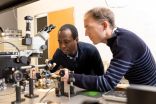(Press-News.org) LA JOLLA--You've misplaced your cell phone. You start by scanning where you remember leaving it: on your bureau. You check and double-check the bureau before expanding your search around and below the bureau. Eventually, you switch from this local area to a more global one, widening your search to the rest of your room and beyond.
When it comes to animals and food, a similar strategy is used to search for food ("foraging"). Now, Salk scientists have developed a mathematical theory--based on roundworm foraging--that predicts how animals decide to switch from localized to very broad searching. This new theory could begin to explain animal behavior in a more unified way, laying the groundwork for general rules of behavior that could help us understand complex or erratic attention-related behaviors, such as attention deficit hyperactivity disorder (ADHD), and even let us predict how extraterrestrials might behave.
"How do you decide which route to take home or which problem to work on? This theory is exploring what ultimately makes us human--how we make decisions based on partial information affects all aspects of our lives," says Tatyana Sharpee, associate professor of Salk's Computational Neurobiology Laboratory and senior author of the paper, which was published in eLife on December 9, 2014.
Worms and other animals often follow a chemical trail (a scent, for example) to find their food. But when no chemicals are present they switch to an "infotaxis" search where information gathering happens in more discrete local and global stages.
"What is surprising is that these simple organisms with a very small nervous system perform--or approximate--fairly complex, multistep, long-term planning strategies," says Sharpee.
This type of search is like looking for a friend at a crowded beach, says Sreekanth Chalasani, assistant professor of Molecular Neurobiology Laboratory, holder of Salk's Helen McLoraine Developmental Chair in Neurobiology and co-senior author of the work. If you think the friend is under a blue umbrella, you won't necessarily charge to the first blue umbrella you see. You'll probably first conduct a more global survey of the scene, glancing at all the umbrellas and ruling out areas where blue does not appear. If you still can't find your friend, you would expand your search to include other locations in addition to under blue umbrellas. Even though you waste some time, you still obtain a lot of information about where this person is likely to be by focusing on things not directly related to your target.
"Seeking information about a target is often better than seeking the target itself," says Chalasani. "And what this paper confirms in a theoretical model is that you don't need lots of neurons to perform these searches that include switching from a local to a global search--you can approximate it by using just three neurons, as in the roundworm C. elegans."
Successfully seeking food is critical to an animal's survival. Previously, C. elegans worms have been shown to conduct an intense search of an area where they believe food to be located. After 15 minutes or so, they turn less and explore a more extended area. Since the worms didn't have a chemical gradient to follow, the team wanted to explore the underlying strategy of the worms' behavior. Using data from Chalasani's experimental studies, Sharpee's lab developed virtual simulations of the worms to model their behavior.
Though this information-maximizing theory has been tested in a few types of behavior, Sharpee and others believe it could provide a basis for a larger, unified framework for understanding different types of behavior across species, cells, neurons and even larger scale phenomenon, such as resource allocation.
Next, the researchers plan to see whether the roundworm can--and to what extent--maintain a mental map of its food search and explore the energy costs and benefits of information searching.
INFORMATION:
Authors of the paper include Adam Calhoun of the University of California, San Diego, in addition to Sharpee and Chalasani.
The work was funded by a National Science Foundation graduate research fellowship, and the UCSD Institute for Neural Computational graduate fellowship to Adam Calhoun, the Rita Allen Foundation to Sreekanth Chalasani and a National Science Foundation CAREER award the National Institutes of Health, McKnight Endowment Fund for Neuroscience and The Ray Thomas Edwards Foundation to Tatyana Sharpee.
About the Salk Institute for Biological Studies
The Salk Institute for Biological Studies is one of the world's preeminent basic research institutions, where internationally renowned faculty probes fundamental life science questions in a unique, collaborative, and creative environment. Focused both on discovery and on mentoring future generations of researchers, Salk scientists make groundbreaking contributions to our understanding of cancer, aging, Alzheimer's, diabetes and infectious diseases by studying neuroscience, genetics, cell and plant biology, and related disciplines.
Faculty achievements have been recognized with numerous honors, including Nobel Prizes and memberships in the National Academy of Sciences. Founded in 1960 by polio vaccine pioneer Jonas Salk, MD, the Institute is an independent nonprofit organization and architectural landmark.
Loyola researchers and collaborators have reported promising results from a novel therapeutic approach for women with estrogen-receptor-positive breast cancer.
The new approach, a new drug class called gamma secretase inhibitors (GSI), specifically inhibits Notch and shuts down critical genes and cancer cells responsible for tumor growth.
Kathy Albain, MD, FACP, who led the study, will present findings Dec. 11 during the 2014 San Antonio Breast Cancer Symposium.
Existing cancer drugs are effective in killing mature breast cancer cells. But a handful of immature breast ...
Children exposed during pregnancy to elevated levels of two common chemicals found in the home--di-n-butyl phthalate (DnBP) and di-isobutyl phthalate (DiBP)--had an IQ score, on average, more than six points lower than children exposed at lower levels, according to researchers at Columbia University's Mailman School of Public Health.
The study is the first to report a link between prenatal exposure to phthalates and IQ in school-age children. Results appear online in the journal PLOS ONE.
DnBP and DiBP are found in a wide variety of consumer products, from dryer sheets ...
Scientists have named the first definite horned dinosaur species from the Early Cretaceous in North America, according to a study published December 10, 2014 in the open-access journal PLOS ONE by Andrew Farke from Raymond M. Alf Museum of Paleontology and colleagues.
The limited fossil record for neoceratopsian--or horned dinosaurs--from the Early Cretaceous in North America restricts scientists' ability to reconstruct the early evolution of this group. The authors of this study have discovered a dinosaur skull in Montana that represents the first horned dinosaur from ...
Nearly 269,000 tons of plastic pollution may be floating in the world's oceans, according to a study published December 10, 2014 in the open-access journal PLOS ONE by Marcus Eriksen from Five Gyres Institute and colleagues.
Microplastic pollution is found in varying concentrations throughout the oceans, but estimates of the global abundance and weight of floating plastics, both micro and macroplastic, lack sufficient data to support them. To better estimate the total number of plastic particles and their weight floating in the world's oceans, scientists from six countries ...
ANN ARBOR--As if holiday travel isn't stressful enough. Now University of Michigan researchers say we're likely sharing that already overcrowded airline cabin with countless tiny creatures including house dust mites.
"What people might not realize when they board a plane is that they can share the flight with a myriad of microscopic passengers-- including house dust mites--that take advantage of humanity's technological progress for their own benefit," said U-M biologist Pavel Klimov.
"House dust mites can easily travel on an airline passenger's clothes, skin, food ...
Massachusetts General Hospital (MGH) investigators have identified two compounds that appear, in cellular and animal models, to block the cardiac damage caused by the important chemotherapy drug doxorubicin. Their report in the Dec. 10 issue of Science Translational Medicine indicates that inhibiting the action of an enzyme that is key to the generation of cellular energy in mitochondria could prevent doxorubicin-induced damage to cardiac cells without reducing the drug's anti-tumor effects.
"Doxorubicin-induced cardiomyopathy limits the amount of the drug a patient ...
Treating the potentially blinding haze of a scar on the cornea might be as straightforward as growing stem cells from a tiny biopsy of the patient's undamaged eye and then placing them on the injury site, according to mouse model experiments conducted by researchers at the University of Pittsburgh School of Medicine. The findings, published today in Science Translational Medicine, could one day rescue vision for millions of people worldwide and decrease the need for corneal transplants.
According to the National Eye Institute, part of the National Institutes of Heath, ...
Rats that received thyroid hormones had a reduced risk for dangerous heart arrhythmias following a heart attack, according to a new study by a team of medical researchers at New York Institute of Technology.
In the NIH-funded study, published in the Journal of Cardiac Failure, the team found that thyroid hormone replacement therapy significantly reduced the incidence of atrial fibrillation - a specific kind of irregular heartbeat, or arrhythmia -- in the rats, compared to a control group that did not receive the hormones.
The finding could have important implications ...
San Diego, Calif., Dec. 10, 2014 -- Engineers at the University of California, San Diego have demonstrated a new and more efficient way to trap light, using a phenomenon called bound states in the continuum (BIC) that was first proposed in the early days of quantum wave mechanics.
Boubacar Kanté, an assistant professor in electrical and computer engineering at UC San Diego Jacobs School of Engineering, and his postdoctoral researcher Thomas Lepetit described their BIC experiment online in the rapid communication section of journal Physical Review B. The study directly ...
Researchers from North Carolina State University and Qatar University have developed a new "high-entropy" metal alloy that has a higher strength-to-weight ratio than any other existing metal material.
High-entropy alloys are materials that consist of five or more metals in approximately equal amounts. These alloys are currently the focus of significant attention in materials science and engineering because they can have desirable properties.
The NC State research team combined lithium, magnesium, titanium, aluminum and scandium to make a nanocrystalline high-entropy ...




